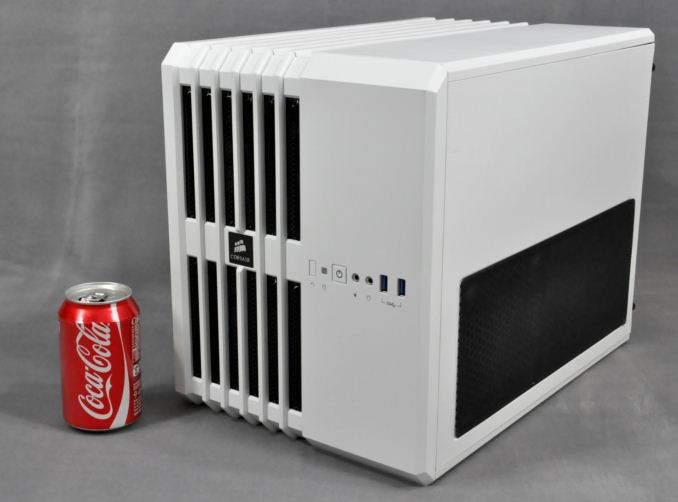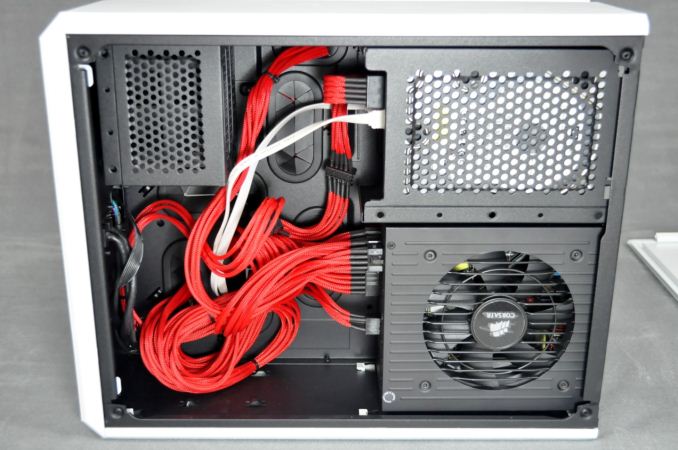Corsair Carbide Air 240 Case Review
by E. Fylladitakis on August 15, 2014 6:00 AM EST- Posted in
- Cases/Cooling/PSUs
- Corsair
- ATX
- Case
- Carbide
Conclusion
Aesthetically, the Carbide Air 240 is certainly eye-catching and very well designed. We cannot really claim that it is a unique case, both because many cubic cases are available and because it is based on the same external design as the Carbide Air 540, a case released over a year ago. However, this does not reduce the aesthetic value of the Carbide Air 240. Based on a minimalistic design of simple geometric shapes and grids, the Carbide Air 240 is a case that attracts attention without being extravagant. It is an understated, yet elegant design that ought to look great on any desk.
Due to its unorthodox shape, there are some limitations as well. For example, despite the width of the case, it is not possible to install very tall CPU coolers, leaving the end user to either settle for a smaller cooler or go for a liquid cooling solution instead. The large width is also going to be a problem for spaces and offices designed to hold standard tower cases, as the cubic Carbide Air 240 will obviously not fit.
One major weakness of the Carbide Air 240 is that there are no external drive slots, for 3.5" or 5.25" devices. Some advanced users have ditched optical media (never mind floppy disks and the like) a long time ago, but others still like to install a DVD-RW or Blu-ray drive. This severely limits the potential of the Carbide Air 240 to be used as a media center. However, that was never the intended purpose of this case, as it has obviously been designed to house little monster gaming PCs, not to function as an HTPC.
When it comes to performance, the Carbide Air 240 delivers as promised. It should easily be able to cover the thermal needs of even the most powerful gaming system that can fit inside it, even with the stock cooling setup if no overclocking takes place. For low-noise setups and overclocking, the installation of at least a good CPU cooler is highly recommended. If a Mini-ITX motherboard is installed, the installation of two liquid coolers, one for the CPU and one for the GPU respectively, can help to create a very powerful system with low operating noise. Unfortunately, due to space limitations, the installation of two GPUs and two liquid coolers does not seem possible, so it would be rather difficult to create a silent dual-GPU gaming system.
As far as quality goes, the Corsair Carbide Air 240 is a very well made product for its class. The plastics are solid and the mechanical cohesion of the chassis is very good as well. Our only complaint would concern the use of metallic meshes as dust filters. Although these metallic meshes are durable and convenient, they will not help with smaller dust particles at all. Furthermore, the panels need to come off in order to clean them, which is not very convenient. The mesh on the right side panel is an exception, as it is denser and can be cleaned very easily.
Recommending the Carbide Air 240 is easy enough, though as usual that depends on individual preferences. Aside from the fact that aesthetics are an entirely subjective matter, which is typically a major factor when it comes to choosing a case, the unorthodox design of the Carbide Air 240 is simply not meant for the majority of the users. Simply put, it is not a product meant for the average Joe to stick beneath an office desk and forget about it. Instead, this is a case meant to show off your powerful and yet compact gaming system, with an eye-catching cubic design. If that's what you're looking for, the Carbide Air 240 is definitely worthy of consideration. Pricing is reasonable as well, with both the white and the black models listed at Amazon and priced at $90 – $40 less than the larger Carbide Air 540.












63 Comments
View All Comments
know of fence - Sunday, August 17, 2014 - link
Do you think that at some point in the future you could arrive at the conclusion, that coolers which consume several times the power, with their failure prone mechanical pumps and fans which also require manual speed adjustment maybe aren't worth the trouble?kyuu - Tuesday, August 19, 2014 - link
Nope, because those "failure prone" pumps and fans are a much more efficient means of cooling. We're talking about desktop systems here, so it consuming a couple extra watts of power isn't really meaningful.I don't particularly care if you prefer air cooling. There are air coolers that work very well; I currently have a Zalman air cooler on my CPU, which replaced the Zalman air cooler on my previous CPU. But CLCs have very real advantages (while not being perfect, as no technology is), so I do take issue with people railing against is though choosing CLCs is somehow wrong.
I have no idea what you're talking about with the requiring manual adjustment thing.
kyuu - Tuesday, August 19, 2014 - link
railing against it as though***Damn lack of an edit button...
StrangerGuy - Saturday, August 16, 2014 - link
IMO this case is terribly designed. If Corsair are going to make a cube case, why not just copy the 250D design, make it fit a mATX mobo and 2x120mm radiator on the left side then be done with. Made even worse without a single 5.25 bay despite all the space at the right side.kyuu - Saturday, August 16, 2014 - link
"Motherboards of up to Micro-ATX size can be installed in the Carbide Air 240, but there is a catch: if you do install a Micro-ATX motherboard, you cannot install a liquid cooling radiator at the bottom of the case. You also cannot really install one at the top panel either, since the fan alone is just a hair away from the top of the motherboard. Therefore, you basically need to choose between two GPUs and a Micro-ATX motherboard, or two large liquid cooling radiators and a Mini-ITX motherboard (presumably with one GPU)."I checked out Corsair's specs, and it says that radiators are intended to be used on the bottom mounts and the *front*. The mounts at the top of the case are not intended for radiators at all, whether you're using mATX or mini-ITX. So you can, in fact, mount a single 240mm rad with an mATX (or, presumably, two 120mm rads) on the front of the case. Which makes me interested in this case.
kyuu - Saturday, August 16, 2014 - link
Though the one thing that would give me pause is if there's room for a thick (~50mm) push/pull radiator on the bottom. Looks like one might not fit due to the GPU, though a thinner one or one with a single fan might.Etern205 - Friday, August 29, 2014 - link
Never like this Corsair case, they want to make it like a cube. A cube is suppose to be compact and yet this is way too large. One problem I still don't get is the back and forth bickering about 5.25" drive bays. I still have a optical drive that I use occasionally, because it's the fastest method for me to install games as I prefer physical media as my bandwidth is consider slow compare to all the others, and other have bandwidth caps, so downloading a 15GB game is out of the question. Also 5.25" drives aren't just only for optical drives. It's not like the computer won't boot up or literally spit out the optical drive. You can use it for many other things like, LCD fan controllers, HDD bays, and many other stuffs. It's useful if you know what to do with it.kenoh - Sunday, August 31, 2014 - link
You can install 3-3.5" HDD's, but how many SSD's can you install?kenoh - Sunday, August 31, 2014 - link
Is it possible for this case to hold 4 SSD's, with all three HDD's installed? BTW, what PSU is used in this review?mekpro - Saturday, September 13, 2014 - link
That's Abit Motherboard !